Office Management with MS Word: Features & Uses
Office Management Tools
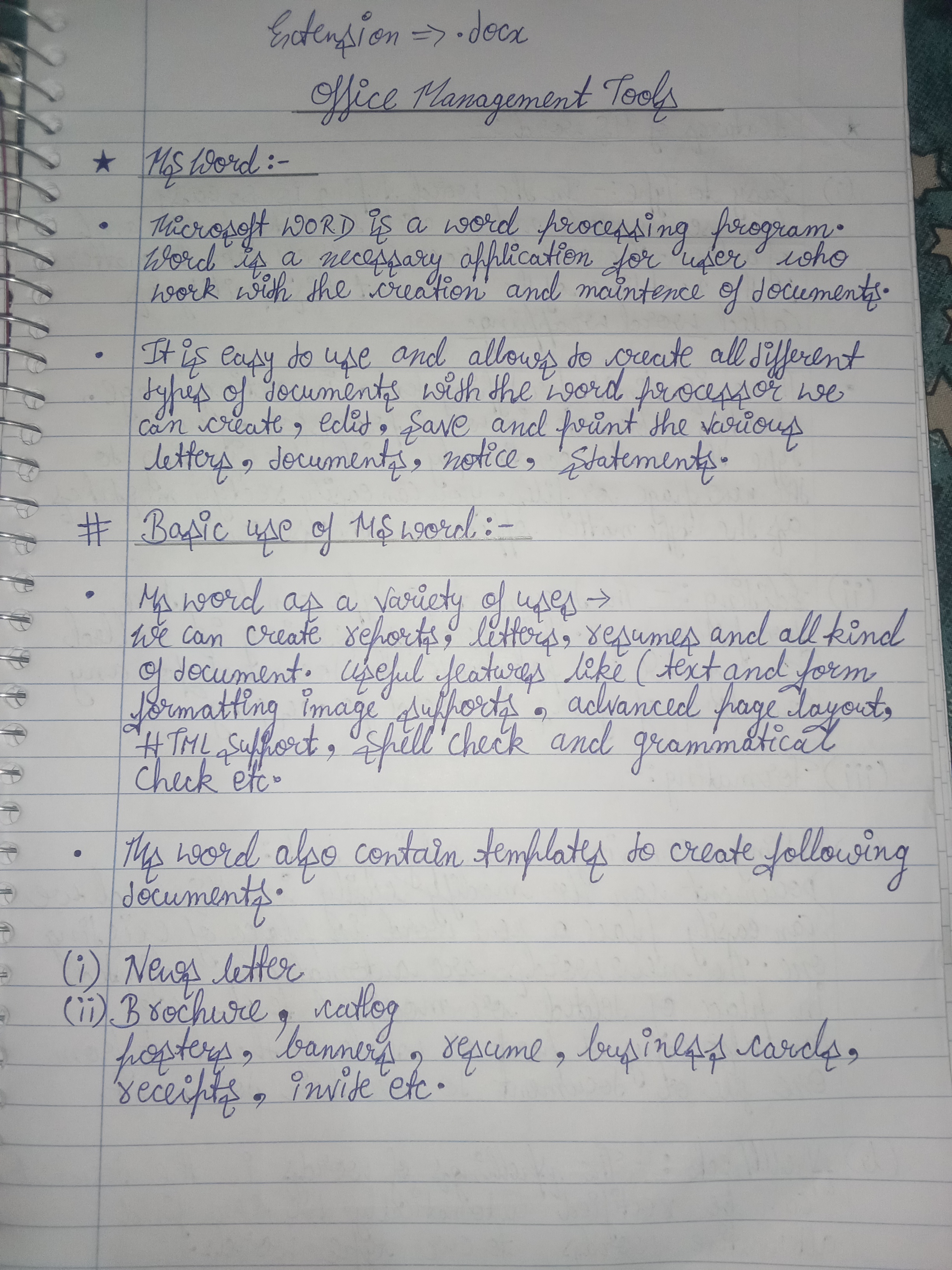
MS Word
- Definition:
- Microsoft Word is a word processing program essential for users to create and maintain various documents.
- Functionality:
-
MS Word is user-friendly and enables the creation, editing, saving, and printing of different document types like letters, notices, and statements.
-
Insights:
- Familiarize yourself with common shortcuts like Ctrl + N (New Document), Ctrl + S (Save), and Ctrl + P (Print) to improve efficiency.
-
Basic Uses of MS Word:
-
Variety of Uses:
-
MS Word can serve multiple purposes, including drafting letters, reports, resumes, and various types of documentation.
-
Additional Features:
- Features such as text formatting, image insertion, advanced page layouts, HTML support, spell check, and grammar check enhance document creation.
-
-
Templates:
- MS Word provides templates for creating various documents easily.
Common Templates Include:
- News Letters
- Brochure
- Catalog
- Flyers
- Banners
- Resume
- Business Cards
- Receipts
- Invitations
- Insights:
- Utilizing templates can significantly cut down the time spent on design, allowing the user to focus on content.
Conclusion
MS Word is an indispensable tool in office management, offering a wide array of functions and features that cater to diverse documentation needs. Understanding the program's capabilities can enhance productivity and streamline workflow.
Extended readings:
Features of MS Word
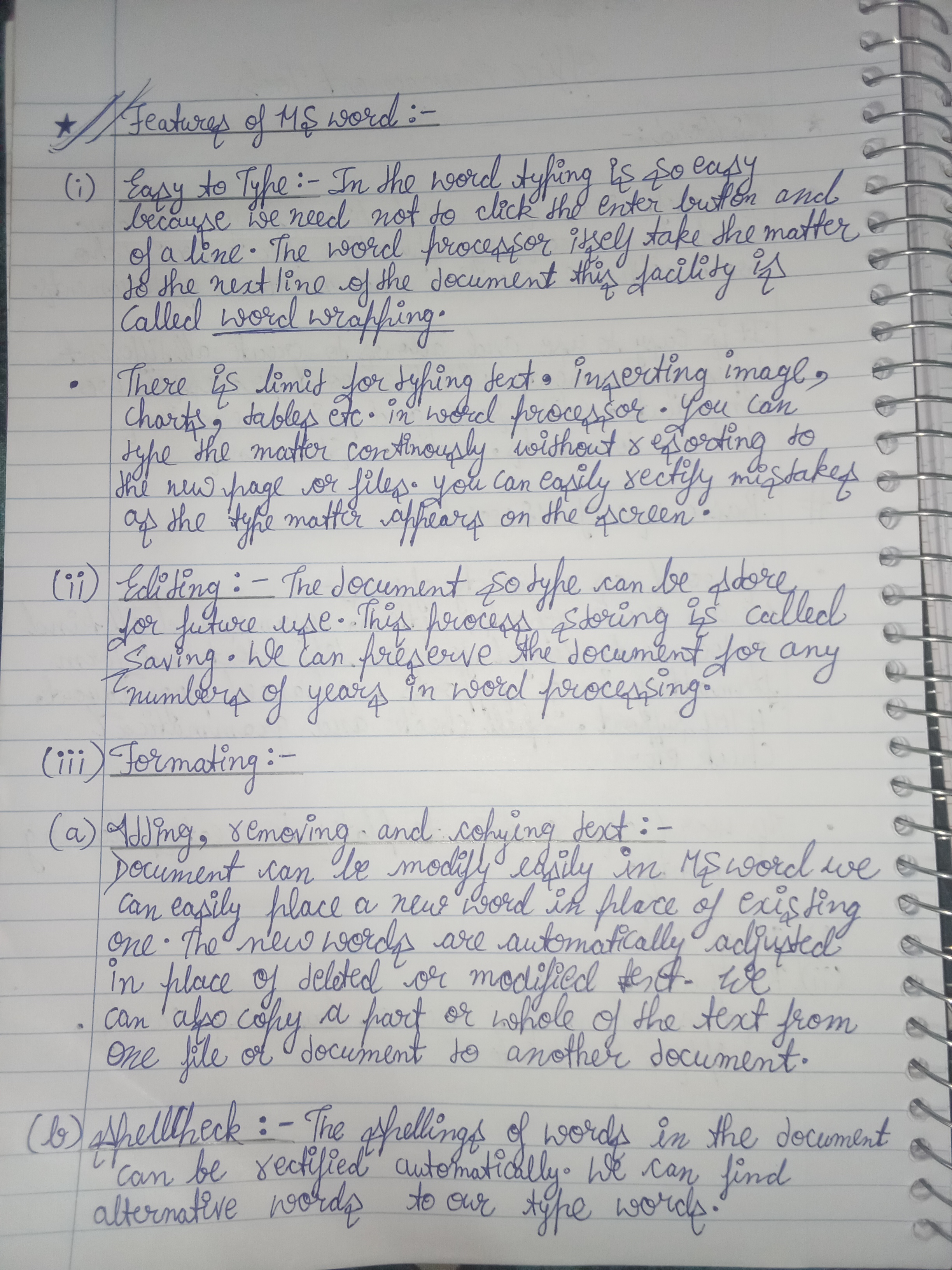
1. Easy to Type
- Description: Typing in MS Word is convenient as users do not need to press the enter button after each line. The program automatically moves the text to the next line, a process known as word wrapping.
- Insight: This feature allows for continuous writing without interruption, making it user-friendly for both casual and professional documents.
2. Document Management
- Inserting Images and Charts: MS Word supports the insertion of various elements such as images and charts. Users can type continuously without needing to switch between documents or pages.
- Insight: This capability enhances the document's visual appeal and enables effective presentation of data alongside text.
3. Editing
- Document Editing: MS Word allows for easy editing of documents, enabling users to save changes for future use.
- Insight: Users can save documents at different stages and recover versions as needed, aiding in version control and minimizing the risk of data loss.
4. Formatting
(a) Adding, Removing, and Copying Text
- Modification: Users can easily modify their documents. New words can replace existing ones seamlessly, and adjustments are automatically made.
- Insight: This flexibility streamlines the writing process and allows for quick updates without the need to restart the document.
(b) Spell Check
- Automatic Correction: MS Word checks the spelling of words within documents and can suggest alternate spellings.
- Insight: This feature assists users in maintaining professionalism in their writing by minimizing typing errors and improving overall writing quality.
Summary
MS Word is a powerful tool for document creation and management, offering features that simplify the typing process, enhance document layout through formatting and media insertion, and provide robust editing capabilities. By utilizing these features effectively, users can create polished and professional documents without significant effort.
Extended readings:
Notes on Document Formatting in Word Processor
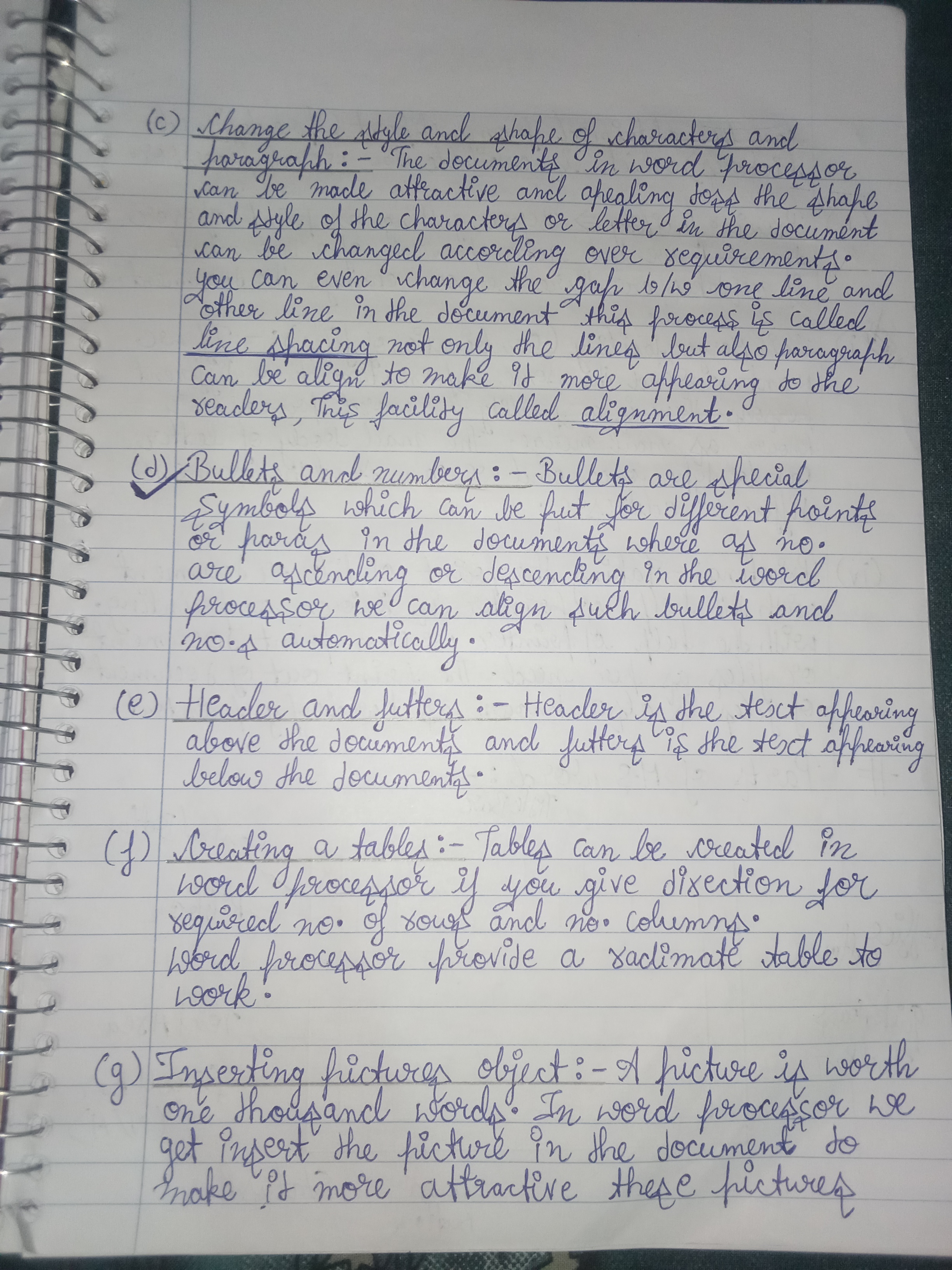
1. Changing Style and Shape of Characters and Paragraphs
- Insight: The ability to modify text styles helps create visually appealing documents.
- Explanation: In word processors, users can change fonts, sizes, and styles (bold, italic, underline) according to their needs.
- Key Feature: Alignment - Adjust line spacing and paragraph alignment to make text more readable. Options include left, center, right, and justified alignment.
2. Bullets and Numbers
- Insight: Using bullets and numbering can simplify information presentation, making it easier to digest.
- Explanation: Bullets represent individual points, while numbers indicate a sequence or hierarchy. Word processors can automate bullet formatting for lists.
- Key Feature: Auto-Numbering - Automatically creates a numbered list as you type.
3. Header and Footer
- Insight: Headers and footers enhance document organization and provide essential information without distracting from the content.
- Explanation:
- Header: Text appearing at the top of each page, often used for titles, dates, or chapter names.
- Footer: Text appearing at the bottom of each page, typically used for page numbers or copyright information.
4. Creating Tables
- Insight: Tables are effective for displaying data in an organized manner, making comparisons and understanding data easier.
- Explanation: Tables can be easily created in word processors by specifying the number of rows and columns needed to structure information clearly.
| Action | Description |
|---|---|
| Direction for Rows/Columns | Specify required number of text cells |
| Formatting | Enhances clarity in presenting data |
5. Inserting Pictures/Objects
- Insight: Visual elements like pictures enhance document appeal and help convey messages more effectively.
- Explanation: Including images can draw attention to key points and can be resized or positioned as needed.
- Key Phrase: “A picture is worth a thousand words” emphasizes the importance of visuals in communication.
These formatting techniques collectively improve the effectiveness and professionalism of documents created in word processors like Microsoft Word.
Extended readings:
Features of MS Word
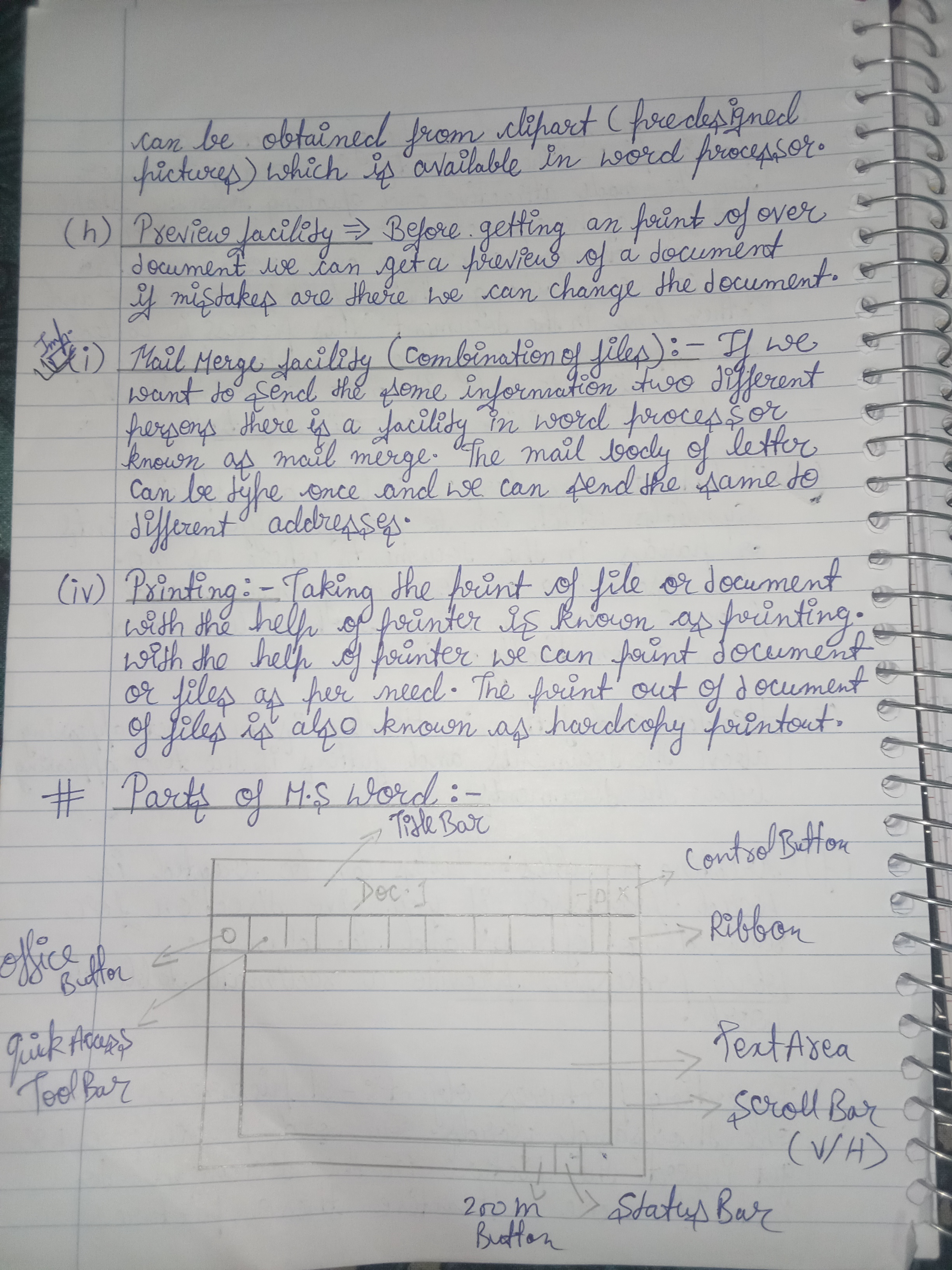
Key Functionalities
-
Preview Facility
- Description: Before printing a document, users can view a preview to ensure everything is correct.
- Insights: This feature helps catch mistakes early. Use the shortcut
Ctrl + Pto access the print preview quickly.
-
Mail Merge Facility
- Description: Combines data from a database with a document to send personalized letters to multiple recipients.
- Insights: Ideal for mass correspondence like invitations or notifications. It allows for the mail body to remain the same while addressing different recipients.
- Use Case: Access this via the "Mailings" tab in MS Word.
-
Printing
- Description: The process of producing a physical copy of a document using a printer.
- Insights: Printing can be customized for various formats and can include features like double-sided printing.
- Tip: Check printer settings to ensure the document is printed as intended, such as selecting paper size and orientation.
Parts of MS Word
| Component | Description |
|---|---|
| Title Bar | Displays the title of the document. |
| Office Button | Provides access to file options, such as saving and opening documents. |
| Quick Access Toolbar | Contains shortcuts for frequently used commands for efficiency. |
| Ribbon | Houses various tabs that contain tools for document editing and formatting. |
| Status Bar | Displays information about the document, like page number and word count. |
| Scroll Bar | Allows users to navigate through the document vertically (V) and horizontally (H). |
| Print Area | Designated space within the document for printing. |
| 200M Button | Likely referring to zoom options to resize document view. |
Additional Insights
- Shortcut Keys: Familiarity with keyboard shortcuts (e.g.,
Ctrl + Sfor saving andCtrl + C/Vfor copy/paste) greatly enhances efficiency when using MS Word. - Formatting Tools: Utilizing paragraph and font formatting tools available in the Ribbon can significantly improve the presentation of the document.
Extended readings:
Customize Tool Bar
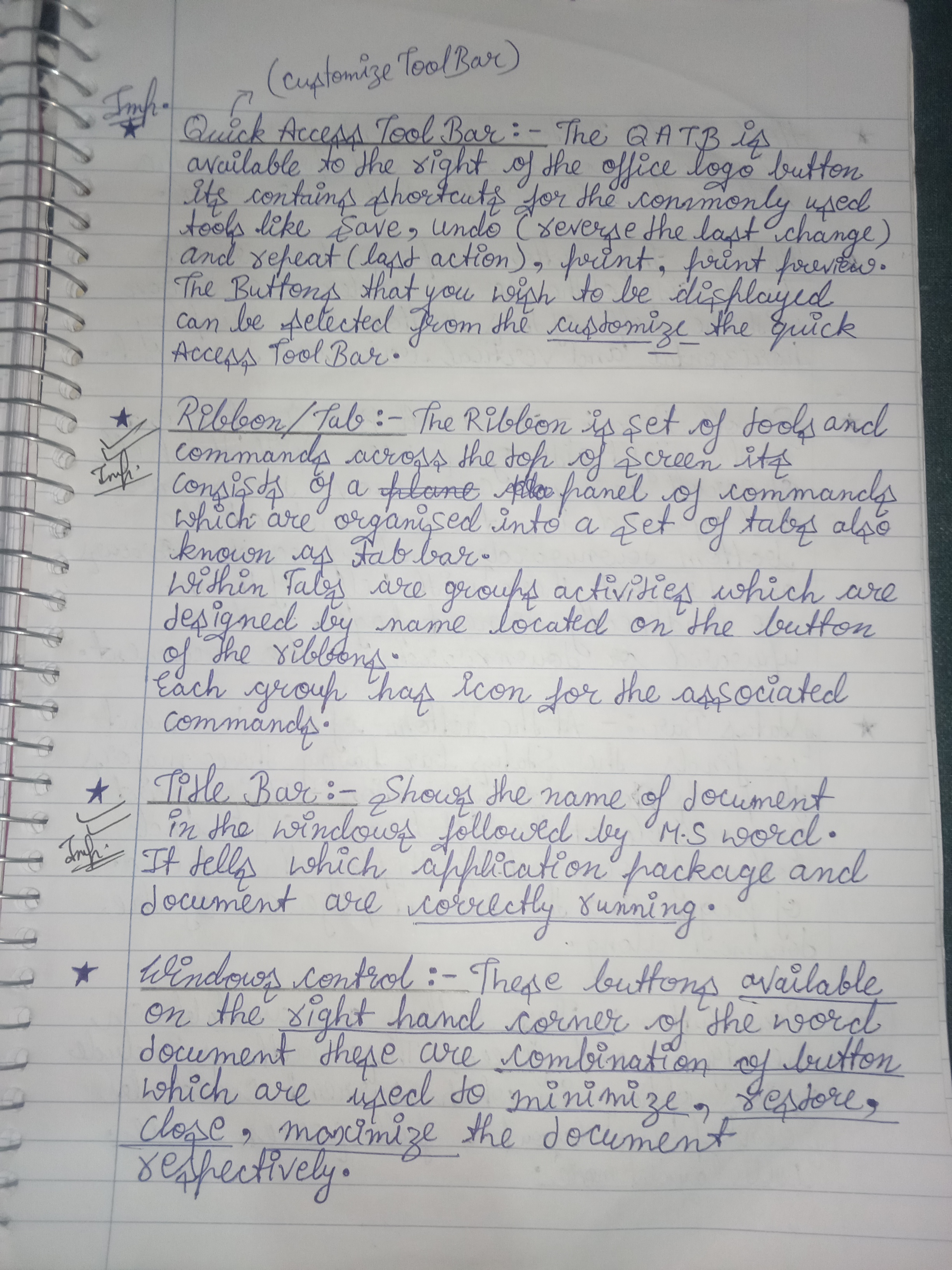
Quick Access Tool Bar (QATB)
- Description: The QATB is located to the right of the Office logo button. It contains shortcuts for commonly used tools like Save, Undo, Redo, Print, and Print Preview.
- Customization: Users can select buttons they want displayed by customizing the Quick Access Tool Bar.
- Insight: The QATB helps streamline frequently performed tasks, enhancing efficiency.
Ribbon/Tabs
- Description: The Ribbon is a set of tools and commands displayed at the top of the screen. It consists of a panel of commands organized into a set of tabs.
- Groups and Activities: Within each tab, there are groups of activities, each identified by an icon located on the button of the Ribbon.
- Insight: Understanding the Ribbon structure can significantly improve navigational efficiency, allowing users to quickly locate desired commands.
Title Bar
- Description: Displays the name of the document in the window followed by "M.S. Word". It indicates which application package and document are currently open.
- Insight: The Title Bar is essential for multitasking as it provides immediate context about the active document.
Windows Control
- Description: These buttons are located in the right-hand corner of the Word document. They are a combination of buttons used to Minimize, Restore, and Close the document.
- Insight: Understanding these controls is crucial for effective window management, enabling users to quickly switch between tasks.
Summary
The customization of toolbars and understanding the layout of MS Word, particularly the Quick Access Tool Bar, Ribbon, Title Bar, and Windows Control, is fundamental for enhancing productivity and streamlining office tasks. Each feature provides essential functionality that caters to efficient document management.
Extended readings:
MS Word Interface Features
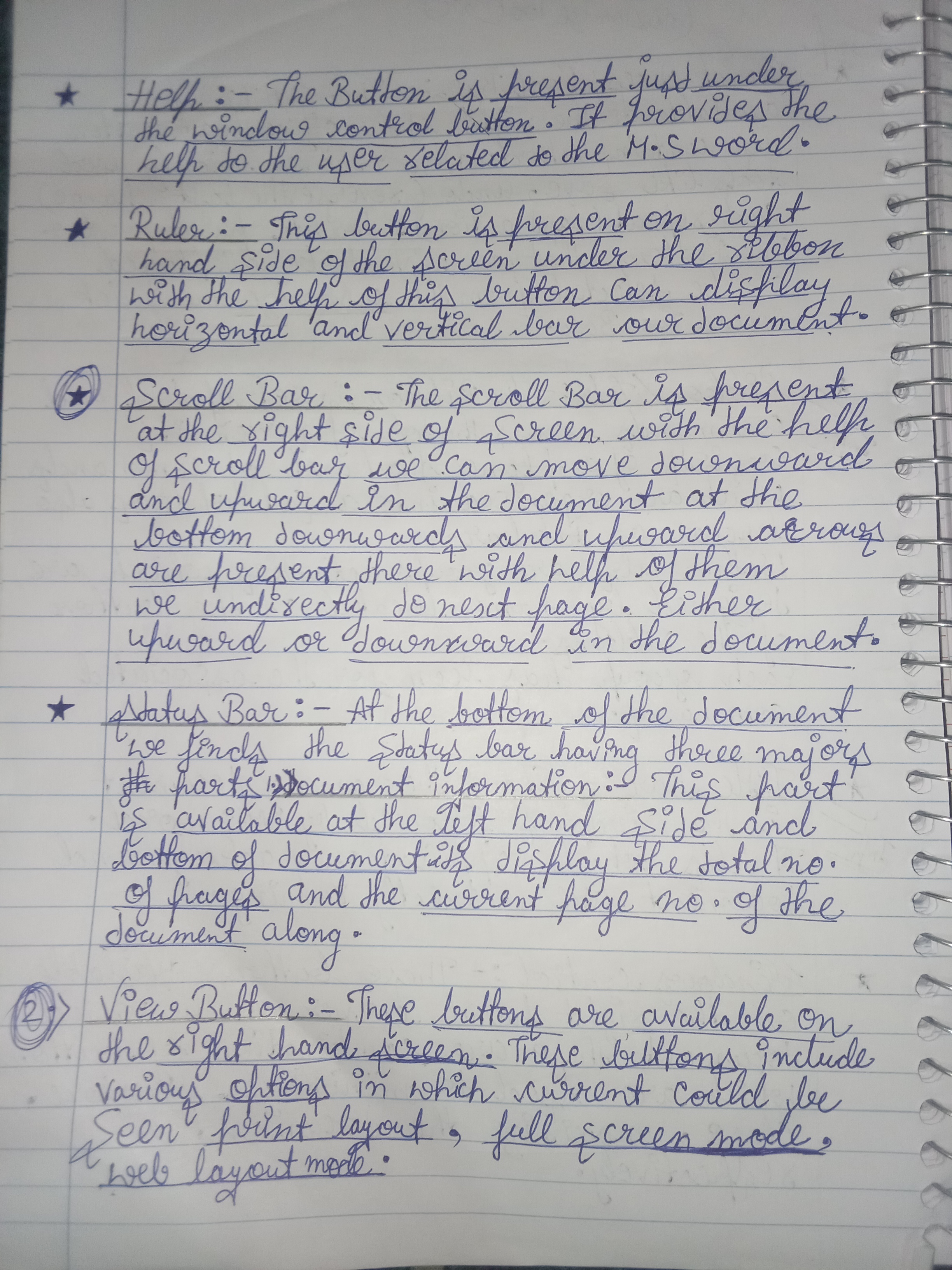
Help Button
- Description: The Help button is located just under the window control button. It provides users with assistance related to the use of MS Word.
- Insights: Utilizing the Help feature can significantly enhance user experience, especially for beginners. Users can access tutorials, troubleshooting tips, and a comprehensive guide on features.
Ruler
- Description: The Ruler button is found on the right side of the screen under the ribbon. It allows users to display horizontal and vertical bars for document alignment.
- Insights: The ruler enhances precision in layout design, allowing users to set margins and indentation easily. Keyboard shortcuts like
Alt + Shift + Rcan quickly toggle the ruler visibility.
Scroll Bar
- Description: The Scroll Bar is present on the right side of the screen. It enables vertical movement through the document to view content above or below the current view.
- Insights: Effective use of the scroll bar speeds up navigation in lengthy documents. Users can click and drag the scroll handle or use the mouse wheel as an alternative method for scrolling.
Status Bar
- Description: The status bar, located at the bottom of the document, provides major document information including the total number of pages and the current page number.
- Insights: The status bar serves as a quick reference for document navigation, helping users keep track of their position and document statistics such as word count.
View Buttons
- Description: These buttons are available on the right side of the screen, providing various display options for the document, including print layout and full-screen mode.
- Insights: The View buttons allow users to change document perspectives effortlessly. The
Ctrl + Alt + Pshortcut switches to Print Layout, whileCtrl + Alt + Ntoggles to Web Layout, facilitating different modes of editing and viewing.
Summary of Key Functionalities:
- Help: Assistance and information access.
- Ruler: For alignment and layout precision.
- Scroll Bar: Essential for navigating long documents.
- Status Bar: Displays crucial document information.
- View Buttons: Offer flexibility in document viewing options.
Extended readings:
MS Word Features and Tools
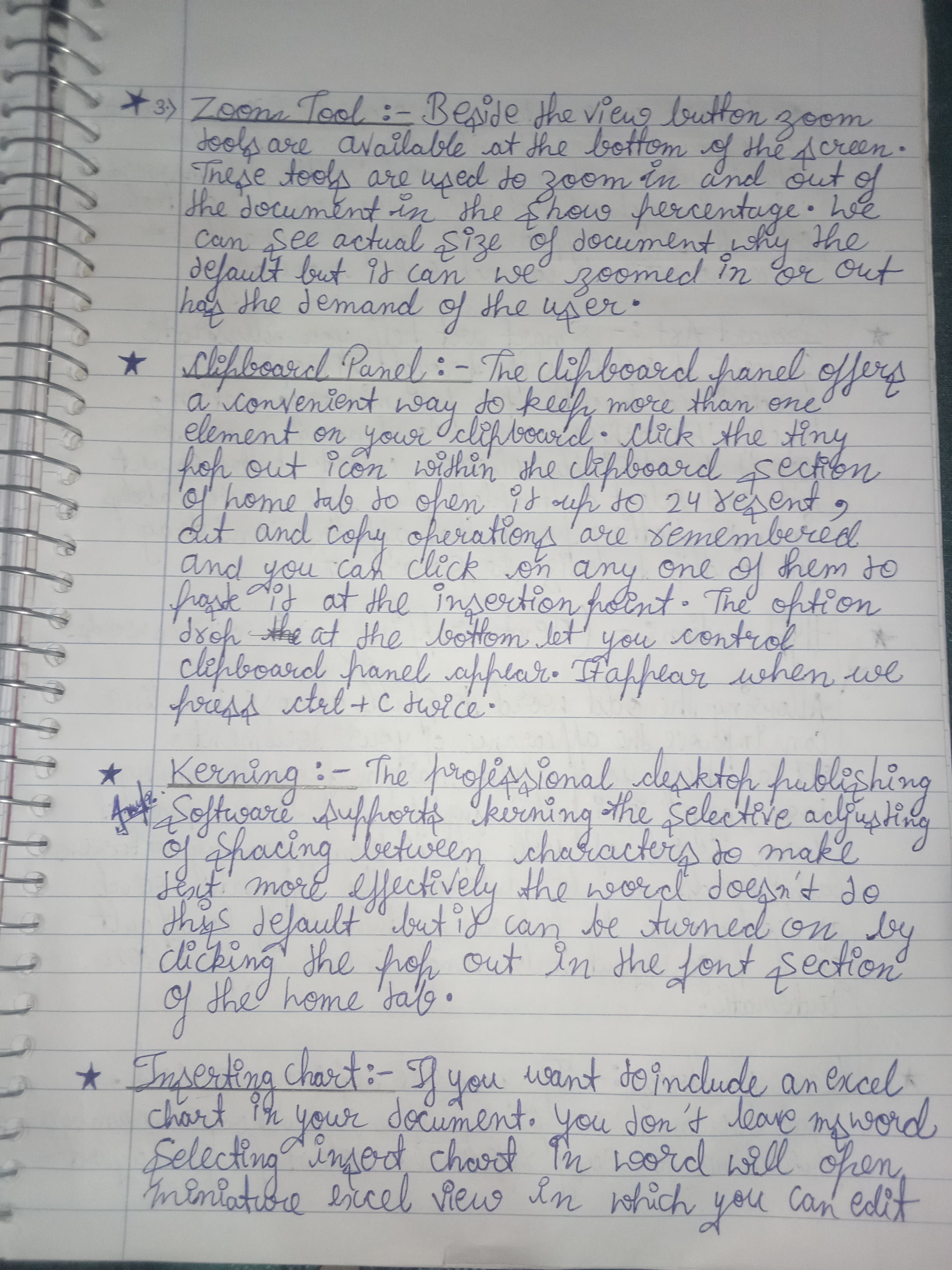
1. Zoom Tool
- Description: The Zoom Tool, located next to the view button at the bottom of the screen, allows users to zoom in and out of a document.
- Usage: It presents the document in "Show Percentage", allowing users to see the actual size of the document.
- Customization: Users can adjust to a preferred zoom level based on their needs.
- Shortcut: Ctrl + scroll wheel for quick zoom adjustments.
2. Clipboard Panel
- Description: The Clipboard Panel provides a convenient way to keep multiple elements on your clipboard for quick access.
- Functionality: You can store up to 24 items in the clipboard section.
- Actions: Cut and copy actions are saved, and users can click on any item to insert it into the document.
- Accessing Clipboard: Users can view the clipboard panel by selecting the appropriate tab within the Home tab.
- Shortcut for Copying: Press Ctrl + C to copy.
3. Kerning
- Description: Kerning is the process of adjusting the spacing between characters in a document.
- Purpose: It helps to improve the readability and aesthetics of text by selectively adjusting spacing.
- Default Setting: This feature is typically turned off but can be activated by accessing the font settings in the Home tab.
- Shortcut for Font Settings: Ctrl + D can open the font dialog to manage kerning options.
4. Inserting Chart
- Description: To include an Excel chart in a Word document, utilize the Insert Chart option.
- Procedure:
- Click on Insert Chart, which opens a mini Excel view within Word.
- This allows users to create and edit charts directly in the document.
- Benefits: Seamless integration of data visualization in text documents enhances clarity and presentation.
Additional Insights
- User Experience: Familiarizing yourself with these tools can significantly enhance workflow and document presentation.
- Efficiency: Using keyboard shortcuts can streamline tasks and save time while working on documents.
- Formatting Consistency: Maintaining consistent formatting, especially with tools like Kerning, can improve readability and professionalism in documents.
Extended readings:
Office Management Tools: SmartArt, Hyphenation, and Line Numbering
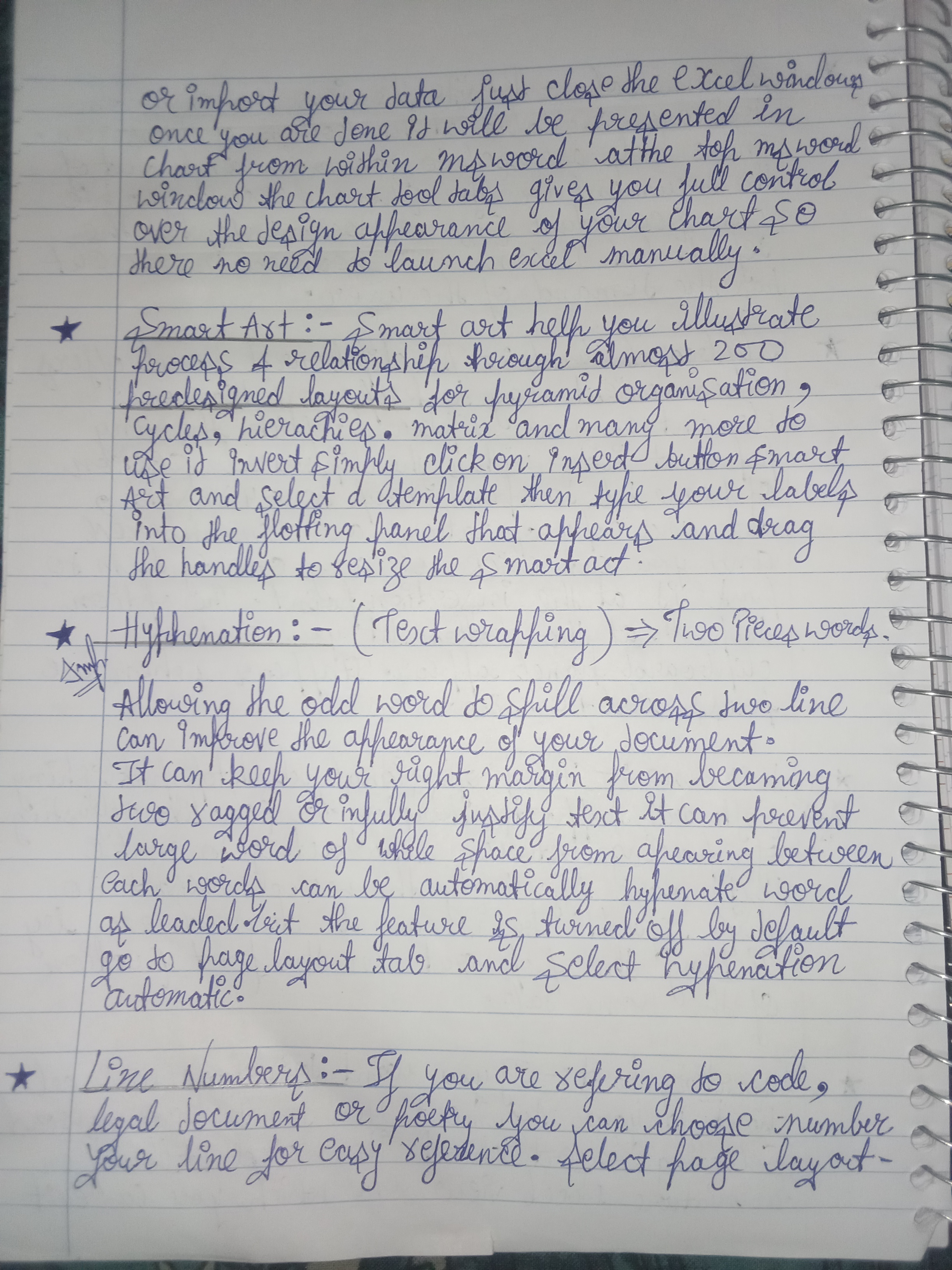
SmartArt
- Definition: SmartArt helps illustrate relationships through various layouts, including diagrams for hierarchical organization, cycles, and matrices.
- Usage:
- To utilize SmartArt, click the "Insert" button in the toolbar and select "SmartArt."
- After selecting a SmartArt template, type your labels into the floating panel that appears.
- Drag the handles to resize the SmartArt.
- Insight: SmartArt is a visual tool that enhances presentations and reports. It allows users to make complex information more digestible and attractive.
Hyphenation
- Definition: Hyphenation allows words to spill across two lines, improving the appearance of a document.
- Benefits:
- Helps maintain right margin alignment and prevents ragged edges in justified text.
- It can automatically hyphenate large words to avoid large gaps between words.
- How to Enable:
- This feature is usually turned off by default. To enable it, go to the "Page Layout" tab and select "Hyphenation" and then "Automatic."
- Insight: Proper use of hyphenation enhances readability and ensures a professional layout in documentation.
Line Numbering
- Definition: Line numbering is a feature that allows users to number lines in a document, useful for legal documents or lengthy texts.
- Usage Steps:
- To add line numbers, select the "Page Layout" tab, then choose "Line Numbers."
- You can select the "Continuous" option for a seamless numbering of lines.
- Additional Information: Line numbering enhances referencing and discussion in documents, making it easier to navigate through lengthy text.
These features are essential for ensuring documents are well-presented and organized, contributing significantly to effective communication in an office environment.
Extended readings:
Notes on Document Formatting and Automation in MS Word
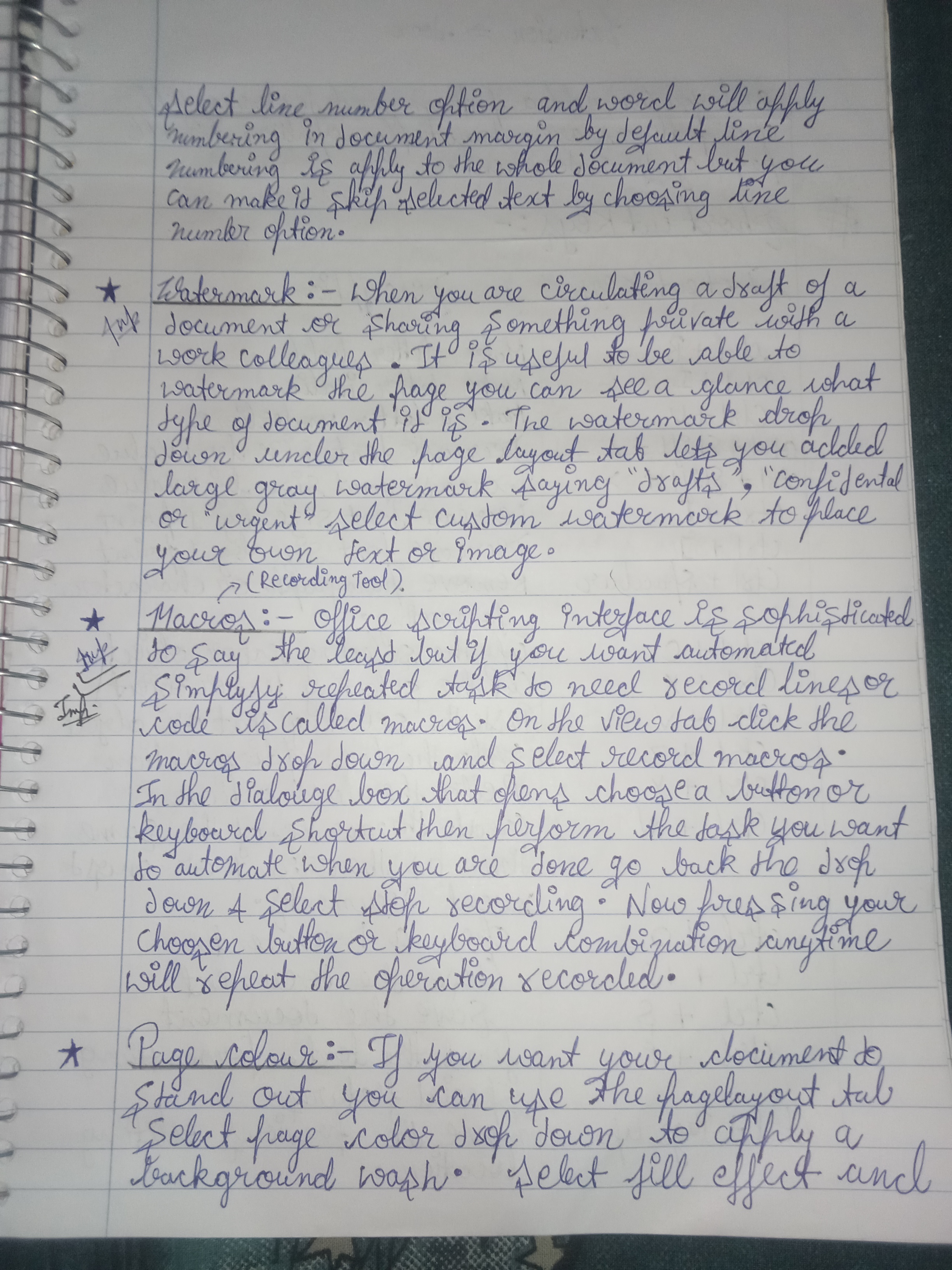
Line Numbering
- Overview: Line numbering can be applied in document margins through the "Line Number" option in Word.
- Insights: This feature is helpful for collaborative work or when reviewing documents. It allows for easy reference to specific lines.
- Key Point: Line numbering can be applied to the whole document or selectively for highlighted text.
Watermark
- Definition: A watermark is an image or text superimposed on a page that indicates the document's status (e.g., "Draft", "Confidential").
- Usage: Helps convey privacy or ownership when circulating drafts among colleagues.
- Action Steps:
- Go to the Page Layout tab.
- Select "Watermark" to add a predefined watermark or create a custom one.
- Ideas: A watermark can help prevent unauthorized printing or copying of sensitive information.
Macro
- Explanation: A macro records a sequence of actions that can be automated to save time on repetitive tasks.
- Steps to Create:
- Open the View tab.
- Click on "Macros" then select "Record Macro".
- Assign a button or keyboard shortcut for easy access.
- Key Insight: Once recorded, the macro can be executed anytime to repeat the automated tasks.
- Benefits: Automates tedious processes, enhancing productivity in document preparation.
Page Color
- Purpose: Changing the page color helps make a document visually appealing or emphasize certain sections.
- Steps:
- Go to the Page Layout tab.
- Select "Page Color" to choose from a palette or customize a color.
- Suggestions: Use contrasting colors for text and background to enhance readability.
Summary
These features combined enhance document aesthetic and functionality, making MS Word not just a word processor, but a versatile tool for professional document management. Familiarity with these functions and their context accelerates proficiency in document preparation tasks. Reading material on specific features can deepen understanding and promote best practices in document design.
Extended readings:
Shortcuts and Features in MS Word
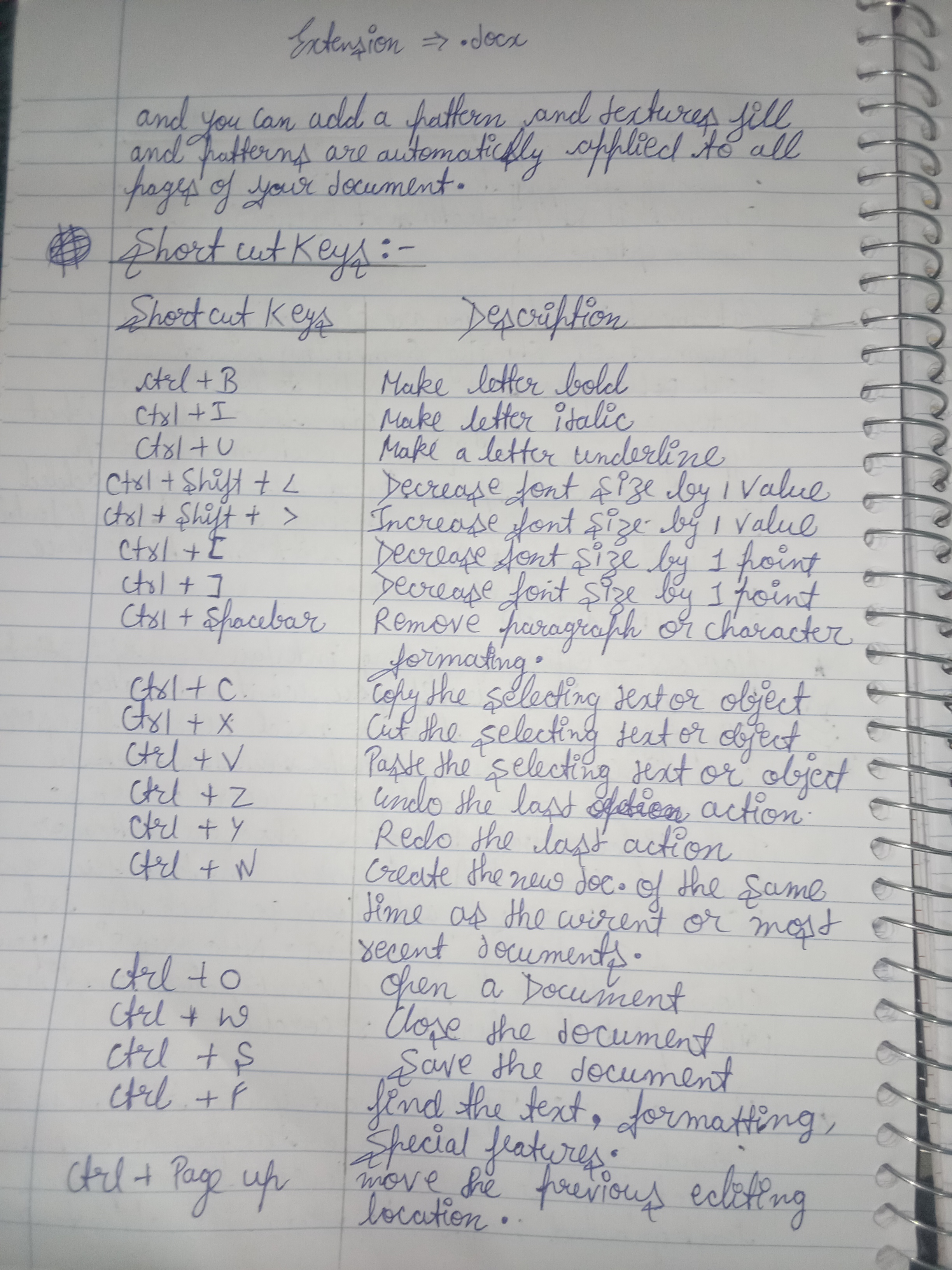
Document Extension
- The default document extension in MS Word is .docx.
- This format allows users to add patterns and textures to documents, which are applied automatically to all pages. This feature enhances the visual appeal and professionalism of documents.
Shortcuts Keys
Overview
Using keyboard shortcuts in MS Word can significantly improve efficiency and speed when navigating and editing documents. Below is a summary of common shortcut keys along with their descriptions.
Shortcut Keys Table
| Shortcut Key | Description | Insight |
|---|---|---|
Ctrl + B | Make text bold | Useful for emphasizing important points. |
Ctrl + I | Make text italic | Ideal for titles or quotes. |
Ctrl + U | Underline text | Helps draw attention to specific details. |
Ctrl + Shift + < | Decrease font size by 1 point | Useful for adjusting text size quickly. |
Ctrl + Shift + > | Increase font size by 1 point | Quick way to enhance readability. |
Ctrl + E | Center align text | Great for headings and important sections. |
Ctrl + L | Left align text | Default text alignment in most documents. |
Ctrl + R | Right align text | Useful for aligning numbers or data. |
Ctrl + 7 | Insert a numbered list | Streamlines organization of points. |
Ctrl + Spacebar | Remove formatting (like bold, italic) | Restores text to default formatting. |
Ctrl + C | Copy selected text or object | Essential for duplicating content. |
Ctrl + X | Cut selected text or object | Moves text rather than duplicating it. |
Ctrl + V | Paste copied or cut text | Completes the cut or copy process. |
Ctrl + Z | Undo the last action | Quick recovery from mistakes. |
Ctrl + Y | Redo the last action | Allows users to restore an undone action. |
Ctrl + N | Create a new document | Opens a fresh workspace for new content. |
Ctrl + O | Open a document | Useful for accessing previously saved files. |
Ctrl + W | Close the current document | Quick way to exit without using the mouse. |
Ctrl + S | Save the document | Important for preventing data loss. |
Ctrl + F | Find specific text | Essential for searching through long documents. |
Ctrl + Page Up | Move to the previous editing location | Helps navigate through lengthy documents. |
Additional Information
- Familiarity with these shortcuts can significantly enhance productivity by reducing reliance on the mouse.
- Users may consider customizing their shortcuts based on individual workflow preferences for even greater efficiency. Understanding the organization of shortcuts is especially beneficial when handling large documents or when speed is critical, such as in collaborative environments.
This summarized guide to shortcuts and features in MS Word should empower users to utilize the tool effectively, making document creation and editing more streamlined.
Extended readings:
Keyboard Shortcuts for MS Word
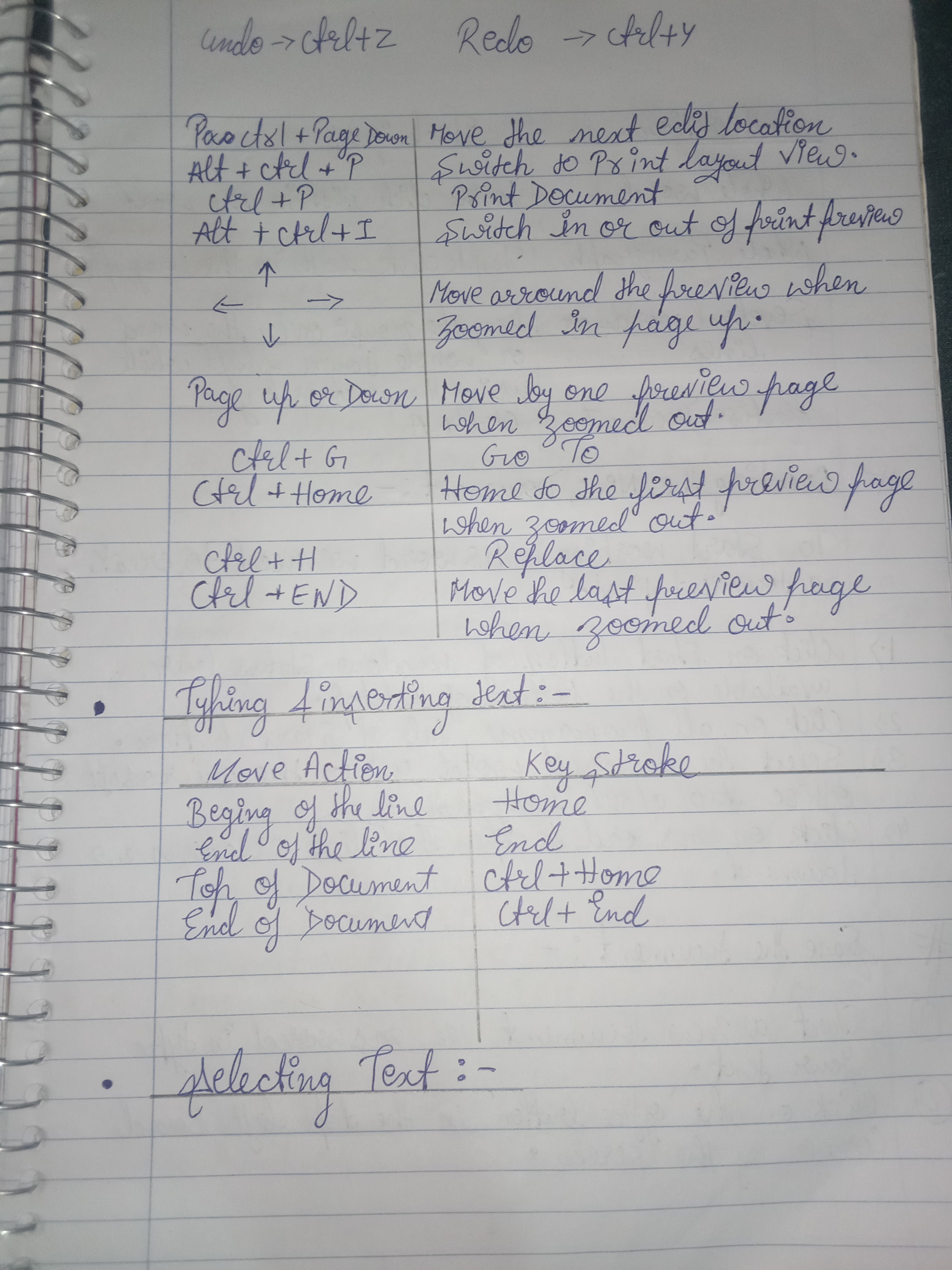
Undo and Redo Actions
- Undo:
Ctrl + Z- Reverts the last action taken, useful for quickly correcting mistakes.
- Redo:
Ctrl + Y- Re-applies an action that was just undone, helpful for redoing changes if you change your mind.
Navigation Commands
| Action | Key Stroke | Description |
|---|---|---|
| Move to the next editing location | Alt + Ctrl + P | Switches to Print Layout View, important for layout checks. |
| Print Document | Ctrl + P | Brings up the print window for printing the document. |
| Move around in preview mode | N/A | Essential when zoomed in on the document. |
Page Navigation
- Page Up / Page Down:
- Used to scroll through pages, essential for reviewing longer documents.
- Go To:
Ctrl + G- Allows you to jump to a specific page or section quickly.
- Home:
Ctrl + Home- Takes you to the first page of the document.
- End:
Ctrl + End- Navigates directly to the last page of the document.
Typing and Text Importing
| Action | Key Stroke |
|---|---|
| Beginning of the line | Home |
| End of the line | End |
| Top of Document | Ctrl + Home |
| End of Document | Ctrl + End |
Insights:
Understanding these shortcut keys can significantly speed up document handling in MS Word, enhancing productivity. For instance, being able to navigate quickly with Ctrl + G and Ctrl + Home/End allows users to work on lengthy documents more efficiently.
Selecting Text
- Efficient text selection is crucial for editing tasks. Techniques can enhance accuracy in selecting specific phrases or sections within your document. The method of selection often varies depending on the context of what you're trying to accomplish, such as copying, pasting, or formatting text differently.
These shortcuts and commands aid in streamlining workflows and making editing in MS Word more intuitive. Mastering these techniques enables users to focus on content rather than getting bogged down by navigation and formatting issues.
Extended readings:
Techniques for Document Selection and Creation in MS Word
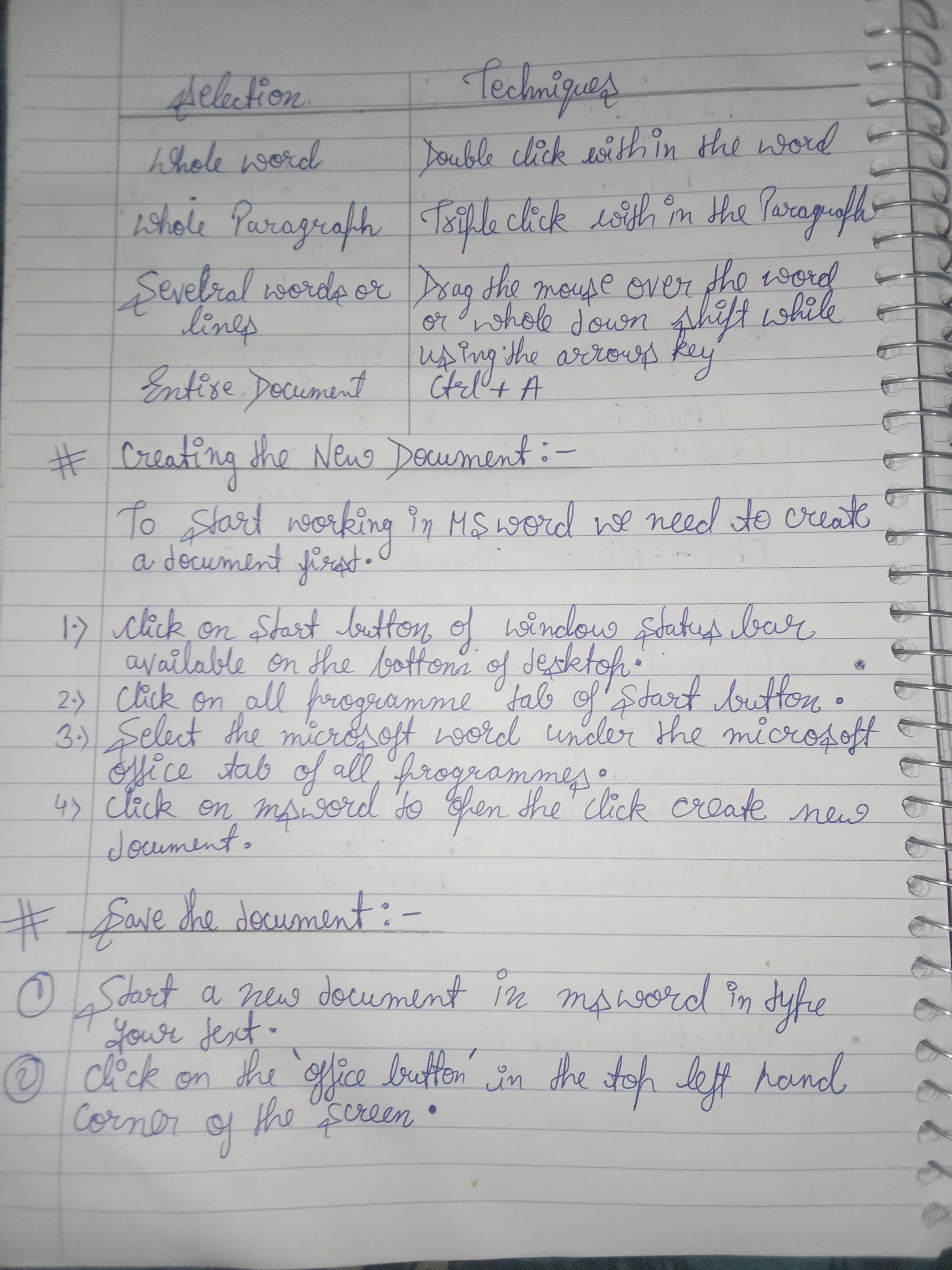
Selection Techniques
| Selection | Techniques |
|---|---|
| Whole Word | Double click within the word. |
| Whole Paragraph | Triple click within the paragraph. |
| Several Words or Lines | Drag the mouse over the words or hold down Shift while using the arrow keys. |
| Entire Document | Use the shortcut Ctrl + A to select the whole document. |
Insights:
- Double Click: This method is quick for selecting a single word and is often used in text editing.
- Triple Click: Useful when you need to edit or format an entire paragraph without having to drag the mouse.
- Shift Key with Arrow Keys: This technique allows for precise selection of text segments, especially useful when working with non-contiguous text.
- Ctrl + A: This is a universal shortcut that can be used across different software to select everything at once, saving time in larger documents.
Creating a New Document
To start working in MS Word, you need to create a document first. Here are the steps:
- Click on the Start button located at the bottom of the desktop.
- Click on all program tabs from the Start menu.
- Select Microsoft Word under the Microsoft Office tab of all programs.
- Click on MS Word to open it and then click Create New Document.
Insights:
- Knowing how to access MS Word quickly enhances productivity, especially in time-sensitive situations.
- Familiarizing with the navigation through the Start Menu can streamline workflow by reducing the time spent searching for applications.
Saving the Document
- Start a new document in MS Word to type your text.
- Click on the Office button in the top left-hand corner of the screen.
Additional Information:
- After clicking on the Office button, there are options for saving, which often include ‘Save’, ‘Save As’, and others.
- Using Ctrl + S is a recommended shortcut for frequently saving your work, ensuring you don’t lose any changes.
- It’s good practice to give your document a meaningful name and select an appropriate file type if you need compatibility with other software.
Extended readings:
Save and Save As Options in Document Management
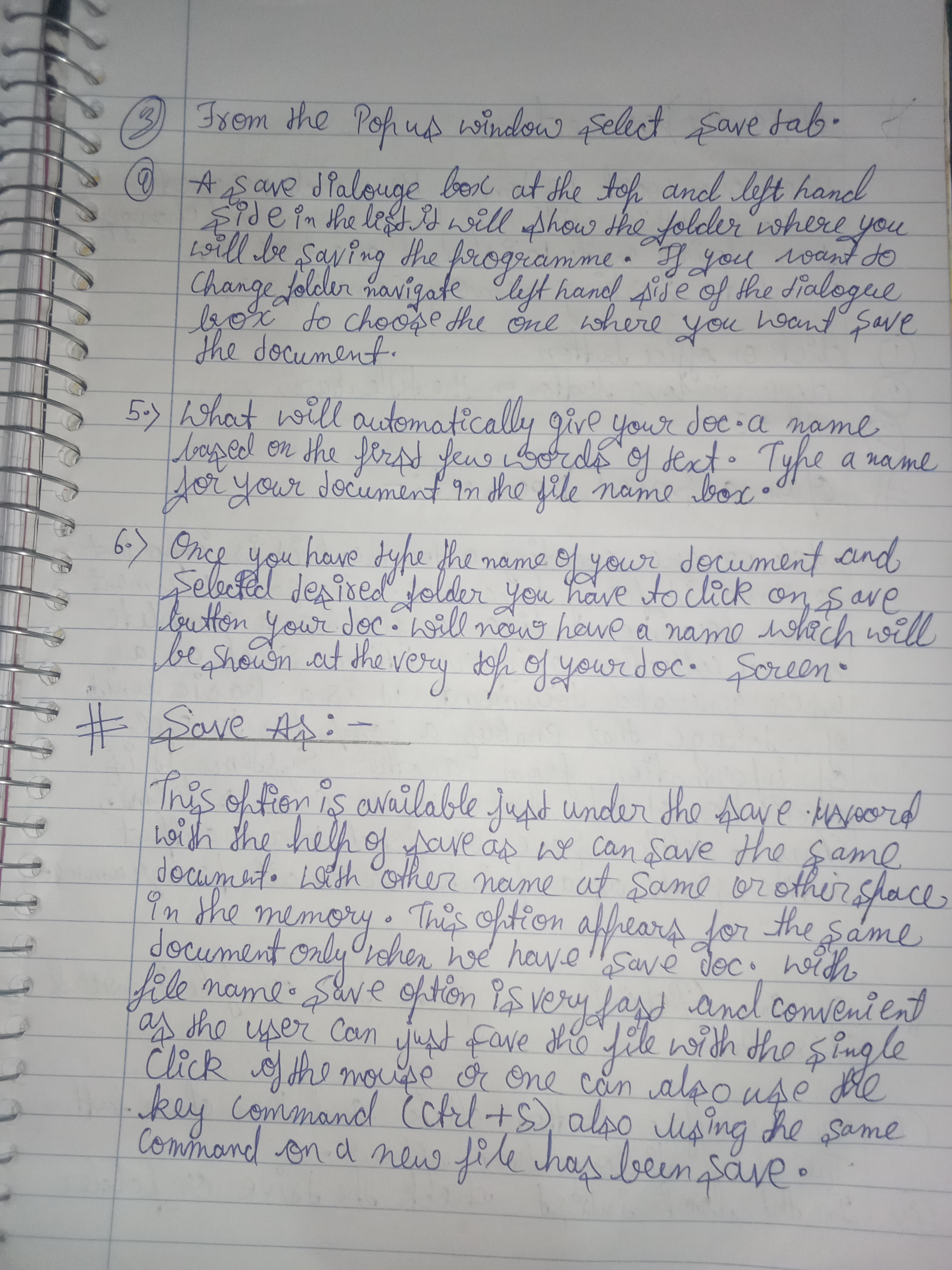
1. Accessing the Save Tab
- Procedure: From the Pop-up window, select the Save tab.
- Insight: The Save operation is crucial for data retention and preventing loss. Always ensure you are saving your work frequently.
2. Understanding the Save Dialogue Box
- Description: A Save dialogue box appears at the top left-hand side of the screen.
- Functionality: It displays the folder where the program will save the document.
- Additional Information:
- You can navigate through this box to select different folders easily.
- The default folder is usually the last location where a document was saved, which can be changed for easier access in the future.
3. Naming Your Document
- Automatic Naming: The system will automatically suggest a name based on the first few words of the text.
- Tip: It is often a good practice to provide a meaningful name to your document that reflects its content, enhancing organization.
4. Selecting the Folder
- Procedure: After typing the document name, navigate to your desired folder and click the Save button.
- Note: The selected folder will be shown at the top of your document’s screen, allowing for a final check before saving.
5. Save As Option
- Definition: This option allows users to save a document under a different name or location.
- Importance: It is especially useful when creating multiple versions of a document or archiving past versions while maintaining the original file.
- Process: Accessible under the Save options with the following steps:
- Click on File.
- Select the Save As option.
Key Benefits of Save As:
- Multiple Formats: Allows saving the document in different formats (e.g., PDF, DOCX).
- Efficiency: Enables the user to save modifications without altering the primary file.
- Keyboard Shortcut: You can also use the command (Ctrl + S) for quick saving; however, for Save As, it’s typically (F12) in many applications.
6. User Accessibility
- Convenience: The Save option is user-friendly, allowing for simple clicks of a mouse or keyboard shortcuts.
- User Control: Offers flexibility in document management, ensuring users maintain control over file names and storage locations.
Summary
Understanding the save and save as functions is essential for effective document management. Regularly saving documents and using the Save As feature for version control are key practices in ensuring data integrity and ease of access.
Extended readings: